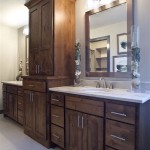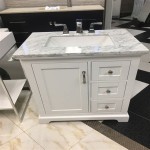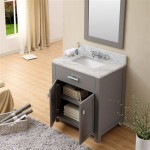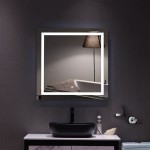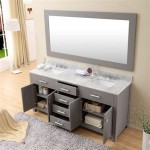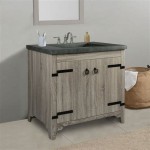Selecting the Ideal 40-Inch Bathroom Vanity
The selection of a bathroom vanity is a crucial step in any bathroom renovation or new construction project. The vanity serves as the focal point of the room, providing storage, concealing plumbing, and contributing significantly to the overall aesthetic. Among the various sizes available, a 40-inch bathroom vanity represents a versatile option, suitable for a range of bathroom layouts and design preferences. This article delves into the key considerations involved in selecting a 40-inch bathroom vanity, covering aspects such as size and space considerations, style and material options, functionality, and installation.
Assessing Space and Size Requirements
Before commencing the search for a 40-inch bathroom vanity, it is essential to accurately measure the available space. Accurate measurements are paramount to ensure the selected vanity fits seamlessly into the intended location without obstructing doorways, walkways, or other fixtures. The 40-inch width represents the horizontal dimension, but other dimensions, such as depth and height, also warrant careful consideration. Standard bathroom vanity depths typically range from 18 to 21 inches, while heights often fall between 30 and 36 inches. Custom depths and heights can be achieved for more bespoke installations.
Beyond the vanity's physical dimensions, adequate clearance around the fixture should be factored in. Allow sufficient space for comfortable movement and accessibility to other bathroom elements, such as the toilet, shower, and storage units. A minimum of 30 inches of clear space in front of the vanity is generally recommended to allow for comfortable use.
Furthermore, consider the placement of existing plumbing lines. If the new vanity is intended to replace an existing one, aligning the plumbing connections can simplify the installation process. If plumbing modifications are necessary, it is advisable to consult with a qualified plumber to ensure compliance with local building codes and proper functionality. The location of the water supply lines and drainpipe will influence the choice of vanity style and configuration. A vanity with an open back or strategically placed cutouts may be required to accommodate existing plumbing.
The overall scale of the bathroom should also be considered to ensure the 40-inch vanity remains proportionate to the room. In a small bathroom, a 40-inch vanity might feel relatively large and dominate the space. Conversely, in a larger bathroom, a 40-inch vanity might appear undersized. Consider the balance and visual harmony within the room when making the selection. It may be useful to create a scaled floor plan or use tape to outline the proposed vanity's footprint to visualize its impact on the space.
For bathrooms with unusual layouts or limited space, a floating vanity might be a suitable option. These vanities are mounted directly to the wall, freeing up floor space and creating a more open and airy feel. The absence of legs also simplifies cleaning and maintenance. However, it is crucial to ensure the wall is adequately reinforced to support the weight of the vanity and its contents.
Exploring Styles and Materials
The style and material of a 40-inch bathroom vanity will significantly impact the overall aesthetic of the bathroom. The selection process should align with the desired design theme, whether it be traditional, modern, contemporary, rustic, or eclectic. A wide range of styles and materials are available, each offering unique characteristics and visual appeal.
Traditional bathroom vanities often feature ornate detailing, raised panel doors, and intricate hardware. These vanities are typically crafted from solid wood, such as oak, maple, or cherry, and finished with a rich stain or paint color. Marble or granite countertops are commonly paired with traditional vanities to enhance their luxurious appeal. The design aesthetic of the surrounding fixtures and other bathroom elements should remain consistent.
Modern bathroom vanities, in contrast, tend to embrace clean lines, minimalist designs, and sleek surfaces. These vanities often incorporate materials such as engineered wood, glass, and metal. Common finishes include high-gloss lacquer, matte paint, and stainless steel. Modern vanities may feature integrated sinks, handleless drawers, and LED lighting. Symmetry and an attention to detail are important elements in modern designs.
Contemporary bathroom vanities strike a balance between traditional and modern styles, incorporating elements of both. These vanities often feature simple yet elegant designs, with a focus on functionality and practicality. A wide range of materials and finishes can be used, allowing for a high degree of customization. Common countertop materials include quartz, solid surface, and glass. The adaptability of contemporary design makes it suitable for a wide variety of bathroom sizes and layouts.
Rustic bathroom vanities are characterized by their natural and organic aesthetic. These vanities often incorporate reclaimed wood, exposed hardware, and distressed finishes. Stone countertops, such as travertine or slate, are commonly used to complement the rustic look. Rustic vanities create a warm and inviting atmosphere, evoking a sense of nature and authenticity. These are often well-suited for larger bathrooms with ample natural light.
Beyond the overall style, the material of the vanity countertop is another crucial consideration. Countertop materials vary in terms of durability, maintenance requirements, and aesthetic appeal. Granite is a popular choice due to its durability, heat resistance, and natural beauty. However, granite requires periodic sealing to prevent staining. Quartz is an engineered stone that offers similar durability to granite but is less porous and requires less maintenance. Marble is a luxurious option but is more susceptible to scratching and staining than granite or quartz. Solid surface materials, such as Corian, are non-porous and easy to clean but can be more prone to scratching. The weight bearing capacity of the supporting structure underneath the countertop should also be considered, especially when selecting natural stones.
Evaluating Functionality and Storage
Beyond aesthetics, a 40-inch bathroom vanity should provide adequate storage and functionality to meet the needs of the user. The storage capacity of the vanity will depend on the number of drawers, cabinets, and shelves it incorporates. Assess the intended use of the vanity to determine the required storage space. Consider items such as toiletries, towels, cleaning supplies, and other personal care products.
Drawers are ideal for storing smaller items, such as makeup, razors, and brushes. Cabinets are better suited for storing larger items, such as towels, hair dryers, and cleaning supplies. Shelves can provide open storage for displaying decorative items or frequently used products. The arrangement and configuration of drawers, cabinets, and shelves should be carefully considered to optimize space utilization.
Soft-close hinges and drawer slides are desirable features that enhance the functionality and durability of the vanity. These mechanisms prevent slamming and reduce wear and tear over time. The hardware should be of high quality and resistant to corrosion, given the humid environment of the bathroom. Consider the accessibility of the storage spaces, ensuring that items can be easily reached without requiring excessive bending or stretching.
The choice of sink style can also impact the functionality of the vanity. Undermount sinks are installed beneath the countertop, creating a seamless and easy-to-clean surface. Vessel sinks are mounted on top of the countertop, adding a stylish and contemporary touch. Integrated sinks are molded directly into the countertop, eliminating seams and simplifying maintenance. The size and shape of the sink should be proportionate to the vanity and the overall bathroom design. The depth of the sink is another consideration, especially for users who prefer a deeper basin.
Consider the possibility of incorporating additional features, such as built-in electrical outlets or USB ports, to enhance the vanity's functionality. These features can be useful for charging electronic devices or powering grooming tools. A built-in organizer can help to keep toiletries and other small items neatly arranged. The inclusion of a pull-out trash can or laundry hamper can also contribute to a more organized and functional bathroom.
The lighting around the vanity should also be carefully considered. Adequate lighting is essential for tasks such as applying makeup, shaving, and grooming. Integrate lighting above the mirror, or sconces mounted on either side of the mirror, provide even and flattering illumination. LED lighting is an energy-efficient and long-lasting option. The color temperature of the lighting should be chosen to complement the overall bathroom design and create the desired ambiance. The use of a dimmer switch allows for adjusting the light intensity to suit different needs.

40 Inch Single Bathroom Vanity In Driftwood Vf12540dw Light Gallery Plus

Fresca Windsor 40 In W Traditional Bathroom Vanity Matte White With Quartz Stone Top Basin Fcb2440whm Cwh U The Home

Fresca Windsor Single 40 Inch Transitional Gray Textured Bathroom Vanity Fcb2440grv Cwh U Bathvanityexperts

The 15 Best 40 Inch Bathroom Vanities For 2024 Bath Vanity In Wide

Home Decorators Collection Bardot 40 In W X 19 D 34 H Single Sink Freestanding Bath Vanity Coffee Bean With White Porcelain Top 30616 The

40 Inch Wide Bathroom Vanities At Com

Park Avenue 40 W White 3 Drawer Single Sink Bathroom Vanity 318t5 Lamps Plus

White 40 Inch Wide Bathroom Vanities At Com

The 15 Best 40 Inch Bathroom Vanities For 2024 Bath Vanity In Wide

Transitional Travertine Bathroom Vanity Single Sink 40 In Wide Wal Com

